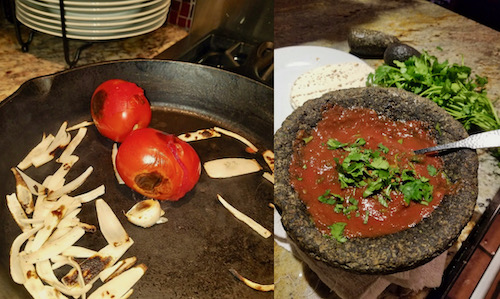Molcajete Salsa Ranchera at Hispanic Association of Colleges and Universities (HACU)

Molcajete salsa ranchera is truly a cornerstone of Mexican gastronomy. This roasted salsa ranchera version has an earthy, smoky taste that makes it perfect for spring cookouts, accompanying roasted vegetables, meats and fish. There are also boiled and fried versions, and of course, the original fresh salsa ranchera.
I’m re-posting this salsa recipe especially for members of the Hispanic Association of Colleges and Universities (HACU) for whom I demo’d how to make it, using a cast iron skillet and comal. Last night was the HACU President, Dr. Antonio Flores, VIP Reception of the annual conference, and as the featured guest I smacked the molcajete, sizzled tomatoes and serranos, and steam-roasted corn tortillas on a high-heat comal.

There is no substitute for the unique taste of salsa ranchera. When I taste it I am instantly and completely transported to my childhood home and family. The combination of flavors is really that distinctive and powerful.

Roasted Salsa Ranchera
Ingredients
2 Roma tomatoes
1 Chile Serrano
1-1/2 ounces peeled and quartered white onion (about 1/8 cup by volume)
1 small garlic clove, unpeeled
1/4 teaspoon salt
Method
1. Place a comal or cast iron skillet over medium heat. Add the chile, tomatoes, onion and unpeeled garlic and cook until they are cooked and soft. They will develop charred black spots.
2. When the ingredients are cooked and charred, place the onion, garlic and salt in a molcajete or other mortar and mash them into a paste. Then slice the roasted chile lengthwise and remove the seeds. Mash the chile to combine with the molcajete ingredients. Finally, add the tomatoes and mash them, combining them thoroughly with the other ingredients. If you are multiplying this recipe to make a big party batch, you can also do this in a blender, but just be careful not to over process. The salsa should have small bits of the charred ingredients for texture. Adjust the salt.
Serve hot or at room temperature.